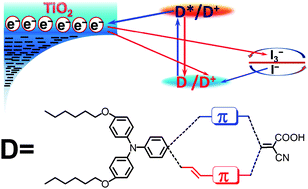The structure–property relationship of organic dyes in mesoscopic titania solar cells: only one double-bond difference†
Abstract
A photosensitizer plays a crucial role in the conversion of solar light to electricity in

* Corresponding authors
a
State Key Laboratory of Polymer Physics and Chemistry, Changchun Institute of Applied Chemistry, Chinese Academy of Sciences, Changchun, China
E-mail:
peng.wang@ciac.jl.cn.
Fax: 86 431 852 629 53
Tel: 86 431 852 629 52
b Key laboratory of Superlight Materials and Surface Technology, College of Materials Science and Chemical Engineering, Harbin Engineering University, Harbin, China
A photosensitizer plays a crucial role in the conversion of solar light to electricity in

 Please wait while we load your content...
Something went wrong. Try again?
Please wait while we load your content...
Something went wrong. Try again?
J. Liu, D. Zhou, M. Xu, X. Jing and P. Wang, Energy Environ. Sci., 2011, 4, 3545 DOI: 10.1039/C1EE01849C
To request permission to reproduce material from this article, please go to the Copyright Clearance Center request page.
If you are an author contributing to an RSC publication, you do not need to request permission provided correct acknowledgement is given.
If you are the author of this article, you do not need to request permission to reproduce figures and diagrams provided correct acknowledgement is given. If you want to reproduce the whole article in a third-party publication (excluding your thesis/dissertation for which permission is not required) please go to the Copyright Clearance Center request page.
Read more about how to correctly acknowledge RSC content.
 Fetching data from CrossRef.
Fetching data from CrossRef.
This may take some time to load.
Loading related content
